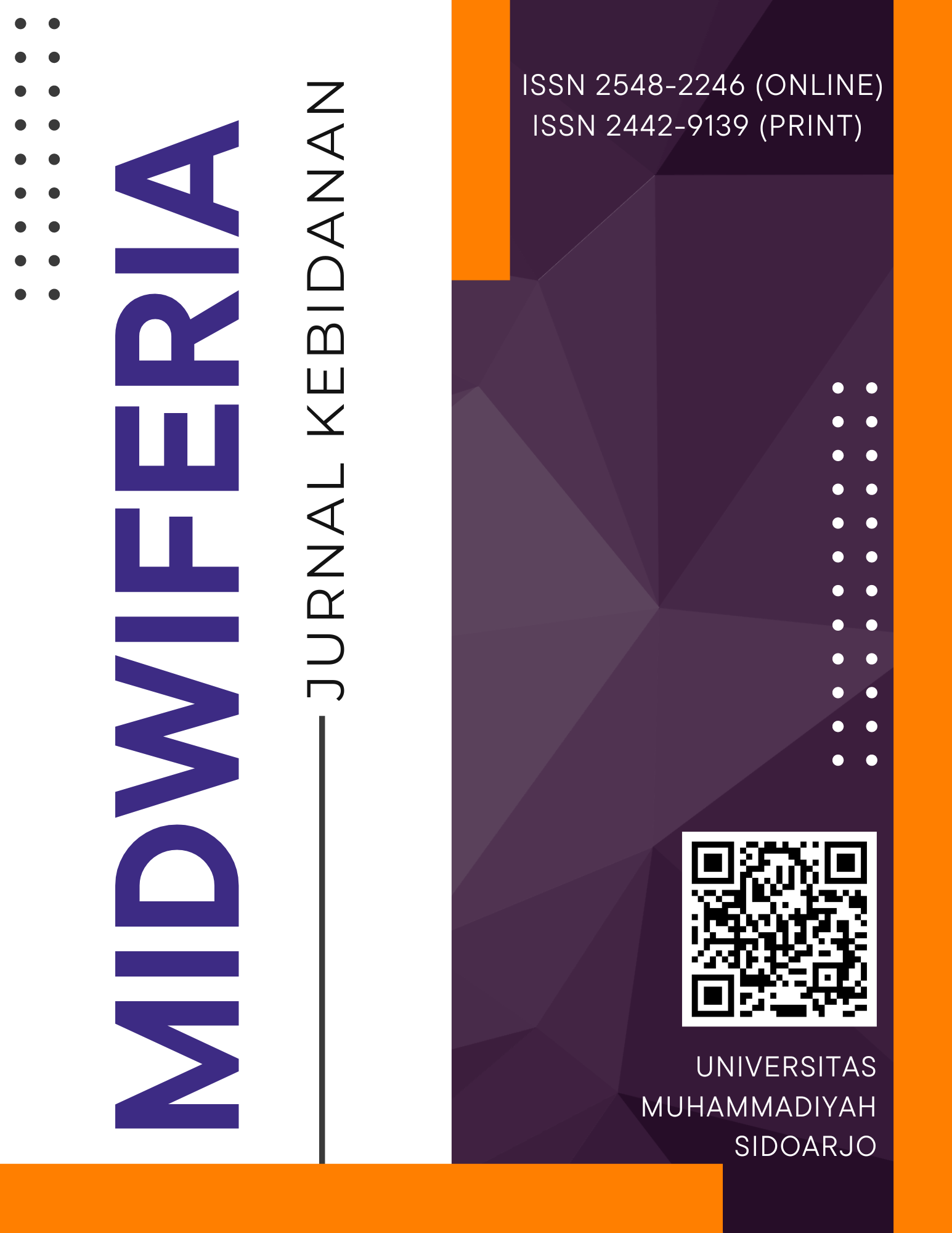The Role of Audio Visual Education in Contraceptive Use in 48-Hour Postpartum Women
Keywords:
Audiovisual, contraceptive education, postpartum contraception, 48-hour postpartum periodAbstract
The 48-hour postpartum period is the ideal time to choose contraception because ovulation can occur 34 days postpartum for mothers who are not breastfeeding optimally. Audio-visual contraceptive education is provided during pregnancy to facilitate contraceptive use during the 48-hour postpartum period. This study aims to determine the relationship between knowledge levels after audio-visual education and contraceptive use during the 48-hour postpartum period. It also aims to identify contraceptive method use during the 48-hour postpartum period. This study is a pre-experimental study with a one-group post-test only design involving 30 pregnant women in the third trimester with a gestational age of ≥ 36 weeks, selected through consecutive sampling. The intervention was provided in the form of audio-visual education. Knowledge levels were measured using a questionnaire after the intervention. Postpartum contraceptive use was identified using medical records. The relationship between knowledge levels after the intervention and contraceptive use during the 48-hour postpartum period was measured using a chi-square test, yielding a p-value of 0.002, indicating a significant association between knowledge after the audio-visual education intervention and contraceptive use during the 48-hour postpartum perio. One of the key components of the Childbirth Planning and Complication Prevention Programme (P4K) is education about contraception during pregnancy. Family planning counselling and contraceptive methods during pregnancy can increase mothers' awareness of contraceptive use.
References
Amelia, R., Maryati, M., & Hardjanti, T. S. (2020). Pengaruh penyuluhan media video TERHADAP peningkatkan pengetahuan DAN sikap TENTANG kontrasepsi intra uterine devices (iud) PADA pasangan usia subur DI kecamatan gunung pati semarang. Jurnal Ners Dan Kebidanan (Journal of Ners and Midwifery), 7(1). https://doi.org/10.26699/jnk.v7i1.art.p024-029
Anwar, R. R., Kalsum, U., & Siregar, N. (2023). The efektifitas edukasi menggunakan video dan booklet pada pengetahuan dan minat kontrasepsi postpartum primigravida di Puskesmas Pasundan. Jurnal Skala Kesehatan, 14(1). https://doi.org/10.31964/jsk.v14i1.378
Darsini, Fahrurrozi, Agus Cahyono, E., SekolahTinggi Ilmu Kesehatan Husada Jombang, S., Korespondensi, A., Veteran Mancar, J., Peterongan, K., Jombang, K., & Timur, J. (2019). Pengetahuan ; artikel review. Jurnal Keperawatan, 12(1). https://doi.org/https://orcid.org/0000-0002-2356-9318
Deviana, Widya Mariyana, Sherli, & Rinda Intan Sari, N. (2023). Hubungan tingkat pendidikan, pekerjaan dan dukungan keluarga terhadap pemilihan metode kontrasepsi jangka panjang pada wanita usia subur di Klinik BPJS Irma Solikin Mranggen Demak. Jurnal Inovasi Riset Ilmu Kesehatan, 1(1).
Jasa, N. E., Listiana, A., & Risneni, R. (2021). Paritas, pekerjaan dan pendidikan berhubungan dengan pemilihan alat kontrasepsi MKJP pada akseptor KB. Jurnal Kebidanan Malahayati, 7(4), 744–750. https://doi.org/10.33024/jkm.v7i4.5243
Kemenkes. (2021). Pedoman Pelayanan Kontrasepsi (1st ed.). Dirjen Kesmas RI, www.repository.kemkes.go.id/book/571
Kementrian Kesehatan Republik Indonesia. (2023). Survei Kesehatan Indonesia. https://www.badankebijakan.kemkes.go.id/hasil-ski-2023/
Lestari, I. G. A. M. A. (2021). Hubungan pengetahuan dengan kesiapan memilih kontrasepsi pascapersalinan pada ibu hamil trimester III di Rumah Sakit Bali Mandara. Poltekes Denpasar. https://repository.poltekkes-denpasar.ac.id/7321/
Mruts, K. B., Tessema, G. A., Gebremedhin, A. T., Scott, J., & Pereira, G. (2022). The effect of family planning counselling on postpartum modern contraceptive uptake in sub-Saharan Africa: a systematic review. Public Health, 206, 46–56. https://doi.org/10.1016/j.puhe.2022.02.017
Mukhdarina, Y., Kirana, R., Hipni, R., & Suhrawardi, S. (2025). Hubungan pengetahuan, umur dan pendidikan ibu dengan penggunaan kontrasepsi implant di wilayah kerja Puskesmas Sungai Bali Kecamatan Pulau Sebuku Tahun 2024. Jurnal Penelitian Multidisiplin Bangsa, 1(8), 1532–1539. https://doi.org/10.59837/jpnmb.v1i8.287
Notoatmodjo, S. (2010). Promosi Kesehatan: Teori dan Aplikasi. Rhineka Cipta.
Pardosi, M., Nababan, D., Brahmana, N. E., Ginting, D., & Sitorus, M. E. (2021). Faktor-faktor yang berhubungan dengan minat ibu bersalin dalam pemilihan alat kontrasepsi kb pascasalin dengan metode kontrasepsi jangka panjang di kecamatan rantau utara tahun 2021 factors related to interest mom in the selection of a contraception equipment post-costal KB with contraception method long term in the district of Rantau Utara. Journal of Healthcare Technology and Medicine, 7(2), 2615–109.
Patmahwati., Mansyur, N., Suriati, I., & Rusad. (2023). Konseling KB dengan memanfaatkan audio visual pada ibu hamil trimester iii terhadap motivasi ibu memilih MKJP pascapersalinan. JKFT, 8(2), 43–49.
Provinciatto, H. , M. D. Y. J. , A. M. S. L. , B. M. M. V. , R. de, F. L. , A. B. C. C. , F. G. C. A. , A. Júnior. ,. (2025). Immediate vs delayed postpartum insertion of long-acting reversible contraception methods: meta-analysis of randomized controlled trials. Am J Obstet Gyneco, 232(2), 139–149.
Rahayu, E. N., Asri Budiningsih, C., & Wara Kushartati, B. M. (2020). Multimedia improves knowledge and choice of contraception among pregnant women. International Journal of Public Health Science, 9(3), 192–198. https://doi.org/10.11591/ijphs.v9i3.20427
Sandari, T. , & S. S. (2024). The Relationship of Parity with The Use of Intra Uterine Device Contraception in Puskesmas Sleman Yogyakarta. Menara Journal of Health Science, 3(4), 519–529.
Downloads
Published
Issue
Section
License
Copyright (c) 2025 Luluk Setiyorini, Ratna Dwi Jayanti, Budi Utomo

This work is licensed under a Creative Commons Attribution 4.0 International License.






